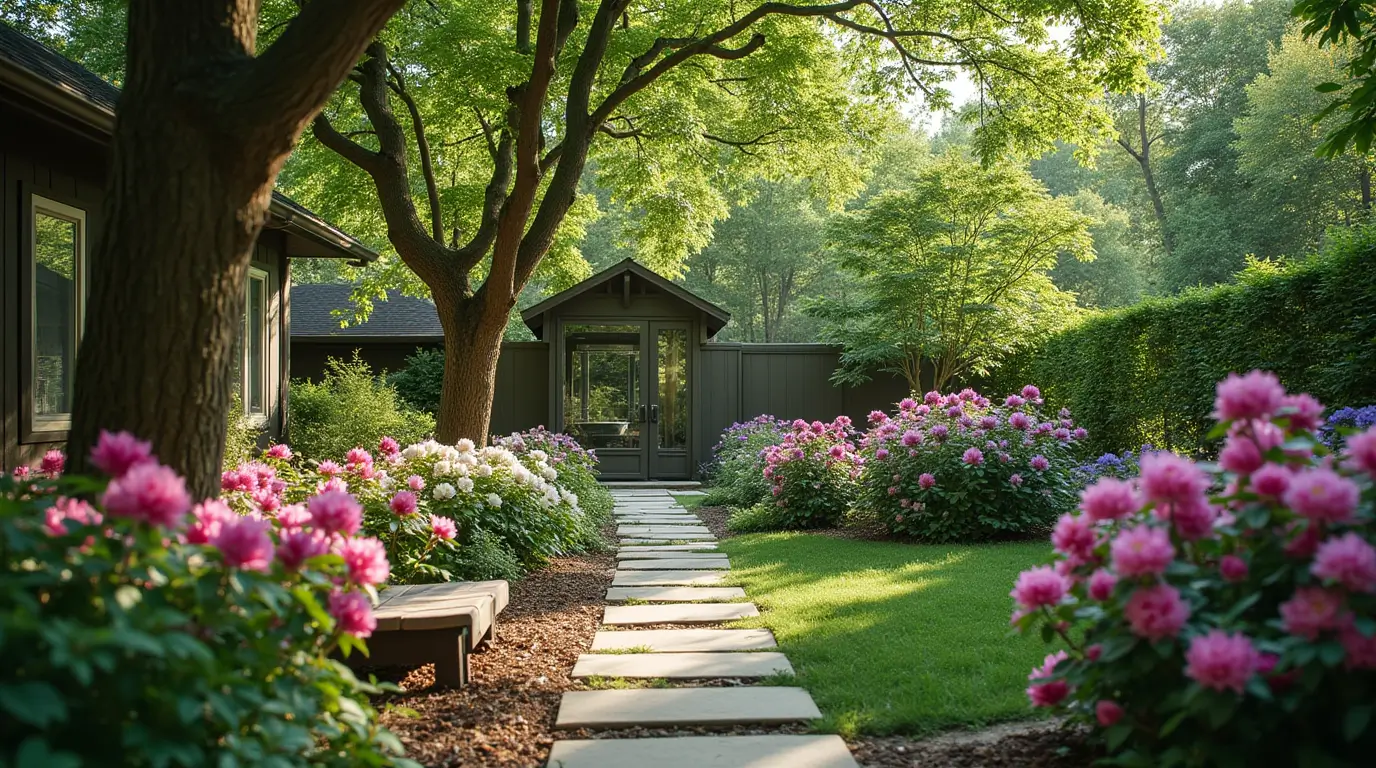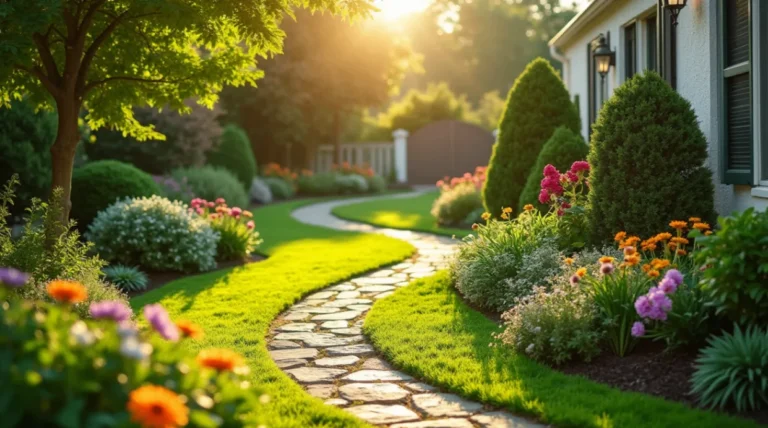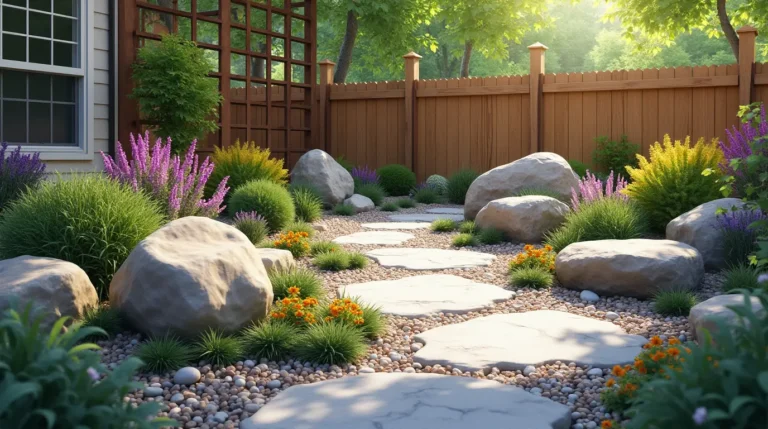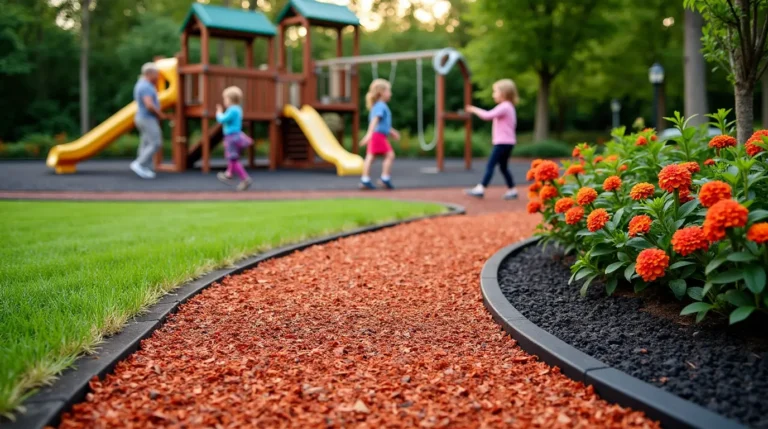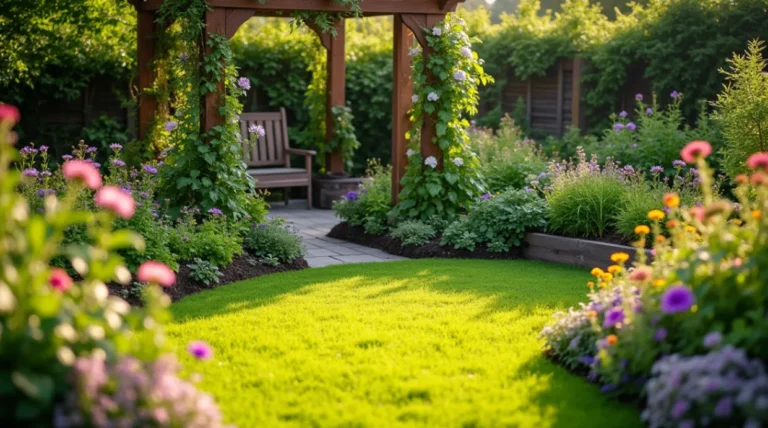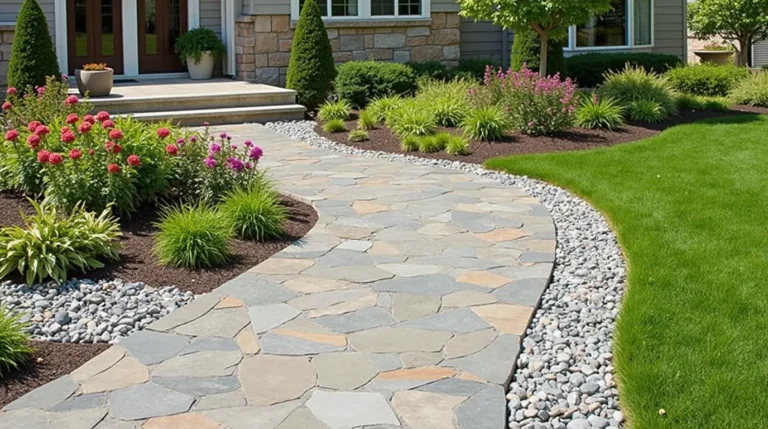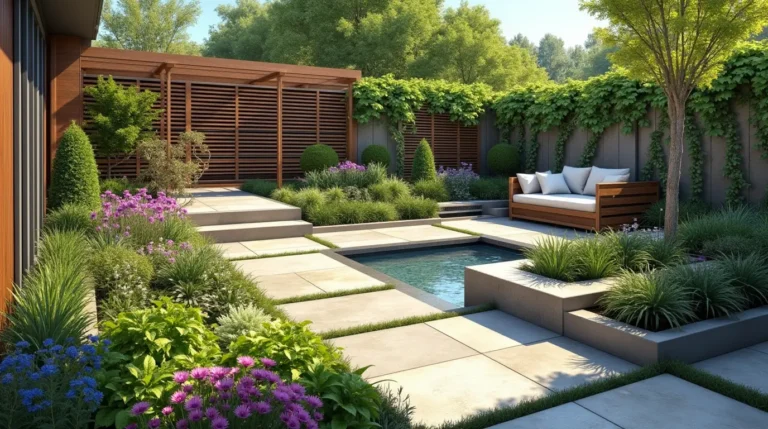Rhododendron Landscaping Uses: How To Design A Stunning Shade Garden
Introduction
When it comes to creating a lush, vibrant shade garden, few plants can rival the beauty and versatility of rhododendrons. Known for their stunning blooms, evergreen foliage, and adaptability to shaded environments, rhododendrons are a cornerstone of Rhododendron Landscaping Uses. Whether you’re looking to add a splash of color to a dim corner, create a serene woodland retreat, or design a low-maintenance yet eye-catching landscape, these hardy shrubs offer endless possibilities. In this guide, we’ll explore how to harness the full potential of rhododendrons, from selecting the right varieties to mastering planting and care techniques. Get ready to transform your outdoor space with the timeless elegance and charm of Rhododendron Landscaping Uses!
1. Why Rhododendrons Are Perfect for Shade Gardens
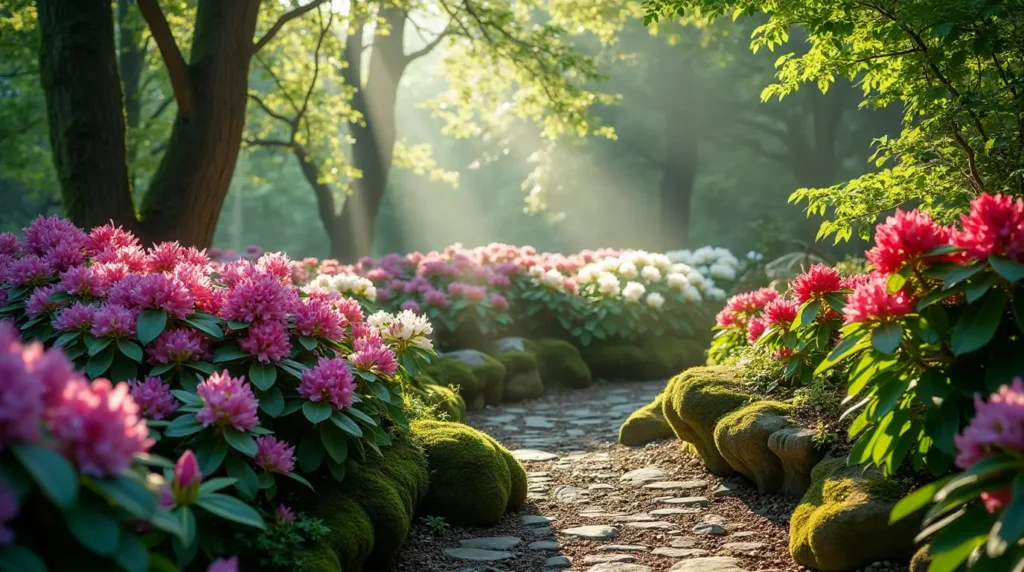
The Natural Habitat of Rhododendrons
Rhododendrons are native to woodland areas and mountainous regions, where they thrive under the canopy of taller trees. This makes them naturally adapted to shaded environments, where they receive dappled sunlight rather than direct, harsh rays. Their ability to flourish in partial shade makes them an ideal choice for Rhododendron Landscaping Uses, especially in gardens with limited sunlight. Whether you’re working with a north-facing yard or a tree-covered landscape, rhododendrons can bring life and color to areas where other plants might struggle.
By understanding their natural habitat, you can replicate these conditions in your own garden. This means providing well-draining, acidic soil and ensuring they’re protected from intense afternoon sun. Their adaptability to shade is one of the key reasons why rhododendrons are a top pick for shade garden design.
Benefits of Using Rhododendrons in Landscaping
When it comes to Rhododendron Landscaping Uses, these versatile shrubs offer a wealth of benefits that make them a favorite among gardeners and landscapers alike. Here’s why they’re perfect for shade gardens:
- Evergreen Foliage: Most rhododendron varieties are evergreen, meaning they retain their lush, green leaves year-round. This provides consistent structure and color to your garden, even during the colder months.
- Vibrant Blooms: Rhododendrons are renowned for their stunning, large blooms that come in a variety of colors, including pink, purple, red, white, and yellow. These flowers add a dramatic pop of color to shaded areas, brightening up otherwise dull spaces.
- Low-Maintenance Nature: Once established, rhododendrons require minimal care. They’re relatively pest-resistant and don’t need frequent pruning, making them a practical choice for busy gardeners.
- Versatility in Design: Whether used as focal points, hedges, or background plants, rhododendrons can be incorporated into various landscaping styles. Their versatility makes them a go-to option for shade garden design.
By leveraging these benefits, you can create a stunning, low-maintenance shade garden that thrives year after year.
Rhododendrons and USDA Hardiness Zones
Before incorporating rhododendrons into your landscape, it’s important to consider your climate and growing zone. Rhododendrons are best suited for USDA hardiness zones 4 through 8, though some varieties can tolerate slightly warmer or cooler conditions.
- Zones 4-6: These cooler zones are ideal for many rhododendron varieties, as they mimic the plant’s native mountainous habitats.
- Zones 7-8: In warmer zones, rhododendrons still thrive but may require additional shade and moisture to prevent stress from heat.
Understanding your zone helps you select the right rhododendron varieties and ensures they’ll flourish in your garden. This knowledge is crucial for maximizing the potential of Rhododendron Landscaping Uses and creating a thriving shade garden.
Key Takeaways for This Section:
- Rhododendrons are naturally adapted to shaded environments, making them perfect for shade gardens.
- Their evergreen foliage, vibrant blooms, and low-maintenance nature make them a standout choice for Rhododendron Landscaping Uses.
- Knowing your USDA hardiness zone ensures you select the right varieties for your climate.
2. Choosing the Right Rhododendron Varieties for Your Garden
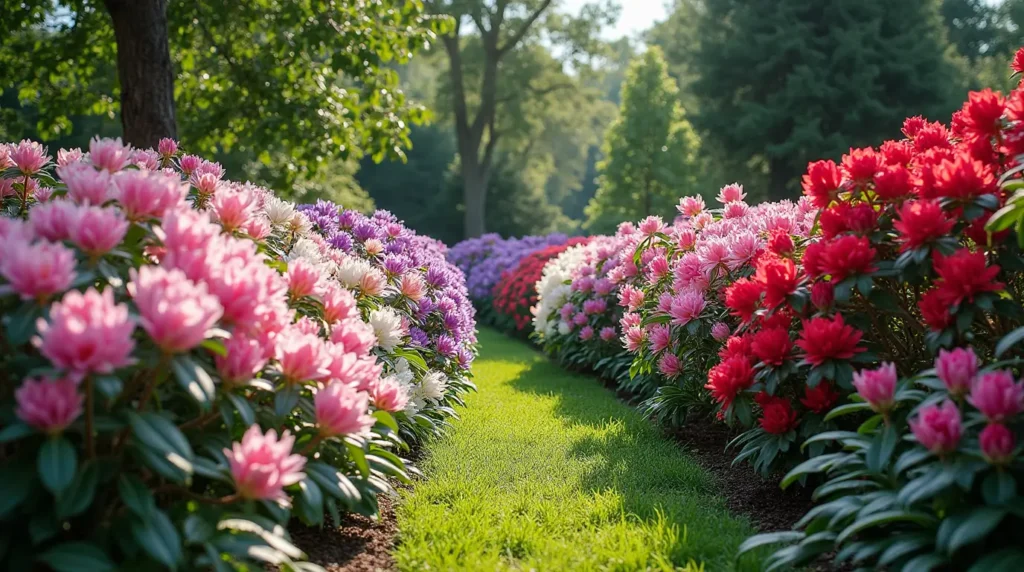
Popular Rhododendron Varieties for Shade Gardens
When planning your Rhododendron Landscaping Uses, selecting the right varieties is crucial to achieving a stunning and cohesive shade garden. Here are some popular rhododendron varieties that thrive in shaded environments:
- PJM Rhododendron: Known for its compact size and vibrant purple-pink blooms, the PJM variety is a favorite for smaller gardens or as a border plant. It’s also highly cold-tolerant, making it ideal for cooler climates.
- Nova Zembla: This variety boasts striking red flowers and glossy evergreen leaves. It’s a larger shrub, perfect for creating a bold focal point in your shade garden.
- Roseum Elegans: With its soft pink blooms and robust growth habit, Roseum Elegans is a classic choice for adding elegance and charm to shaded areas.
- Catawbiense Boursault: This variety features lavender-blue flowers and is particularly hardy, making it a reliable option for gardeners in colder zones.
By choosing the right varieties, you can ensure your Rhododendron Landscaping Uses align with your garden’s aesthetic and functional needs.
Factors to Consider When Selecting Rhododendrons
To make the most of Rhododendron Landscaping Uses, it’s important to consider several factors when selecting the right varieties for your garden:
- Bloom Color and Timing: Rhododendrons come in a wide range of colors, from soft pastels to bold hues. Consider how their blooms will complement your garden’s color scheme. Additionally, some varieties bloom in early spring, while others flower later in the season. Selecting a mix can extend the visual interest in your garden.
- Size and Growth Habit: Rhododendrons vary significantly in size, from compact shrubs under 3 feet tall to larger varieties that can reach 6 feet or more. Think about the space you have available and how the plant’s growth habit will fit into your overall design.
- Climate Adaptability: Ensure the varieties you choose are well-suited to your local climate and USDA hardiness zone. This will help them thrive with minimal effort.
- Maintenance Requirements: Some rhododendrons require less maintenance than others. If you’re looking for easy-care options, prioritize varieties known for their resilience and disease resistance.
By carefully considering these factors, you can select rhododendrons that not only enhance your garden’s beauty but also align with your Rhododendron Landscaping Uses goals.
Pairing Rhododendrons with Other Acid-Loving Plants
One of the keys to successful Rhododendron Landscaping Uses is creating a harmonious plant community. Rhododendrons thrive in acidic soil, so pairing them with other acid-loving plants can enhance both their health and visual appeal. Here are some excellent companion plants:
- Azaleas: Close relatives of rhododendrons, azaleas share similar soil and light requirements. Their smaller size and diverse bloom colors make them perfect for layering in front of larger rhododendrons.
- Ferns: The delicate, feathery fronds of ferns provide a beautiful contrast to the bold foliage and blooms of rhododendrons. They also thrive in shaded, moist environments.
- Hostas: Known for their lush, textured leaves, hostas add depth and variety to shade gardens. Their foliage comes in a range of colors, from deep green to variegated patterns.
- Camellias: These evergreen shrubs produce stunning flowers in late winter or early spring, extending the blooming season in your garden.
By combining rhododendrons with these companion plants, you can create a layered, dynamic shade garden that maximizes the potential of Rhododendron Landscaping Uses.
Key Takeaways for This Section:
- Selecting the right rhododendron varieties is essential for successful Rhododendron Landscaping Uses.
- Consider factors like bloom color, size, climate adaptability, and maintenance requirements when choosing varieties.
- Pairing rhododendrons with other acid-loving plants enhances both their health and visual appeal.
3. Designing a Stunning Shade Garden Layout
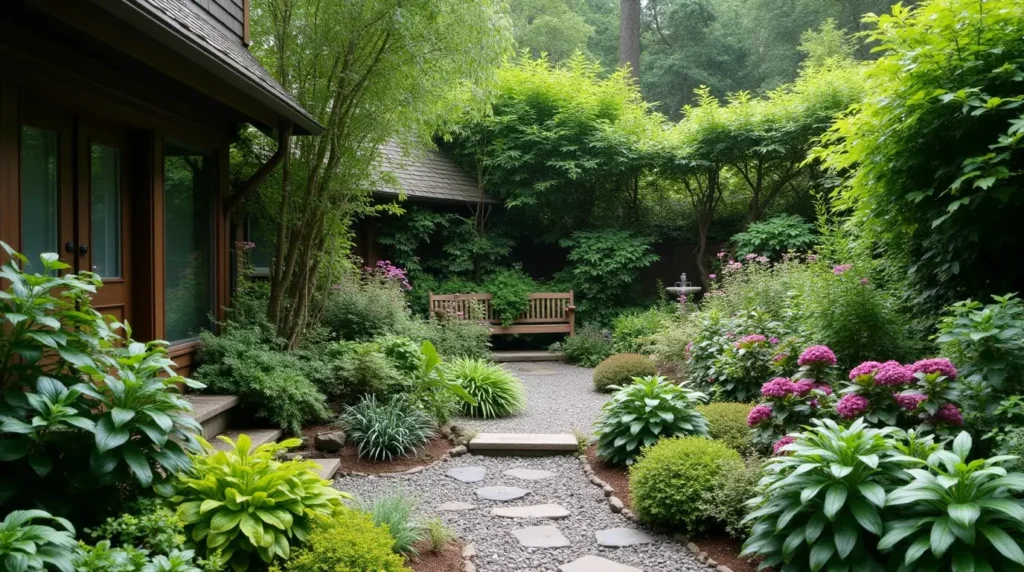
Planning Your Garden Space
When it comes to Rhododendron Landscaping Uses, thoughtful planning is the foundation of a successful shade garden. Begin by evaluating the amount of sunlight your garden receives and the space you have available. Rhododendrons thrive in partial shade, so identify areas that receive dappled sunlight or morning sun with afternoon shade.
- Map Your Garden: Sketch a rough layout of your garden, noting areas with shade, partial shade, and full sun. This will help you determine where to place your rhododendrons for optimal growth.
- Consider Mature Sizes: Rhododendrons can vary greatly in size, so plan for their mature dimensions to avoid overcrowding. Leave enough space for air circulation, which helps prevent diseases.
- Think About Accessibility: Ensure pathways or clearings are included in your design for easy maintenance and enjoyment of your garden.
By carefully planning your garden space, you can maximize the potential of Rhododendron Landscaping Uses and create a cohesive, functional layout.
Creating Visual Interest with Layers and Textures
A well-designed shade garden uses layers and textures to create depth and visual appeal. Rhododendrons are perfect for this purpose, as their bold foliage and vibrant blooms can serve as focal points or backdrops. Here’s how to incorporate them effectively:
- Background Layer: Use taller rhododendron varieties, like ‘Nova Zembla’ or ‘Catawbiense Boursault,’ as a backdrop. Their height and evergreen foliage provide structure and year-round interest.
- Mid-Layer: Add medium-sized plants, such as ferns or hostas, in front of the rhododendrons. Their contrasting textures and colors create a dynamic visual effect.
- Foreground Layer: Include low-growing plants like creeping phlox or hellebores to fill in gaps and add a finishing touch to your design.
By layering your garden, you can create a lush, multi-dimensional space that highlights the beauty of Rhododendron Landscaping Uses.
Incorporating Color Schemes for Year-Round Appeal
One of the most exciting aspects of Rhododendron Landscaping Uses is the opportunity to play with color. Rhododendrons offer a wide range of bloom colors, from soft pinks and purples to bold reds and whites. Here’s how to design a shade garden with a cohesive and appealing color scheme:
- Seasonal Blooms: Choose rhododendron varieties that bloom at different times to ensure continuous color throughout the growing season. For example, pair early-blooming ‘PJM Rhododendron’ with mid-season ‘Roseum Elegans.’
- Foliage Contrast: Don’t forget about foliage! Rhododendrons’ evergreen leaves provide a rich green backdrop, but you can enhance this with variegated hostas or golden ferns for added contrast.
- Complementary Colors: Use a color wheel to select complementary or analogous colors for a harmonious look. For instance, pair purple rhododendrons with yellow-flowering companions like hellebores.
By thoughtfully incorporating color schemes, you can create a shade garden that’s visually stunning and highlights the versatility of Rhododendron Landscaping Uses.
Adding Functional and Aesthetic Elements
Beyond plants, consider adding functional and aesthetic elements to enhance your shade garden design. These elements can elevate the overall experience and make your garden more enjoyable:
- Garden Paths: Use natural materials like gravel, stepping stones, or mulch to create pathways that guide visitors through your garden.
- Seating Areas: Incorporate a bench or small seating area where you can relax and enjoy the beauty of your rhododendrons.
- Garden Accents: Add decorative elements like birdbaths, garden sculptures, or fairy lights to create a magical atmosphere.
These additions not only improve the functionality of your garden but also highlight the beauty of Rhododendron Landscaping Uses by framing them in a well-designed space.
Key Takeaways for This Section:
- Planning your garden space is essential for successful Rhododendron Landscaping Uses.
- Layering plants and incorporating textures create depth and visual interest.
- Thoughtful color schemes and functional elements enhance the overall appeal of your shade garden.
4. Preparing Soil and Planting Rhododendrons
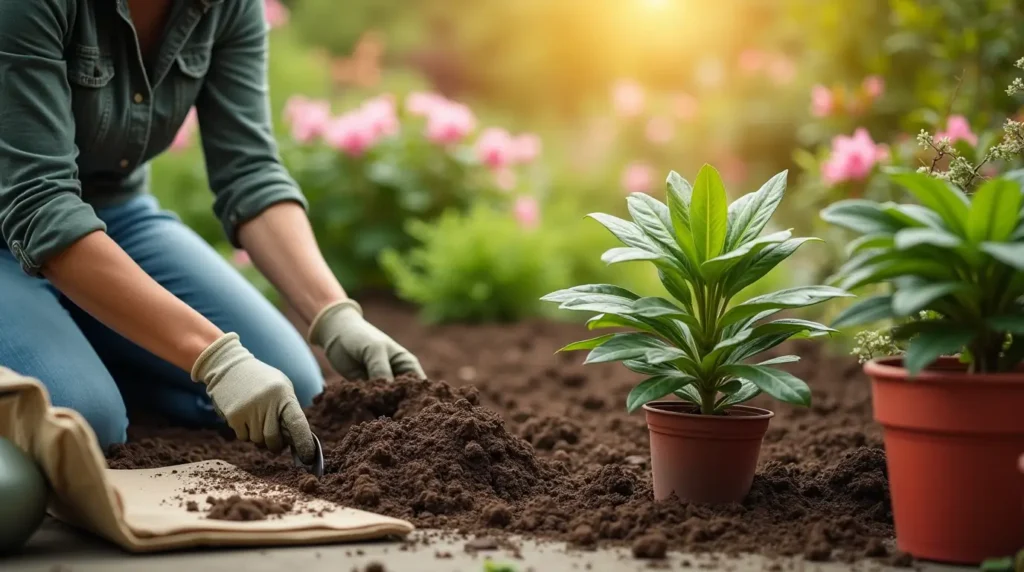
Understanding Soil Requirements for Rhododendrons
One of the most critical aspects of successful Rhododendron Landscaping Uses is ensuring the soil meets the specific needs of these plants. Rhododendrons flourish in acidic soil, ideally with a pH between 4.5 and 6.0. This slightly acidic condition enables them to efficiently absorb vital nutrients, supporting robust growth and vibrant flowering.
To check your soil’s pH, you can use a soil testing kit, which is readily available at most garden centers.If your soil is too alkaline, you can amend it with organic materials like pine bark, peat moss, or sulfur to lower the pH. Additionally, rhododendrons require well-draining soil to prevent root rot, as they are sensitive to waterlogged conditions.
By understanding and addressing these soil requirements, you lay the foundation for a thriving shade garden that highlights the beauty of Rhododendron Landscaping Uses.
Steps to Amend and Improve Soil Quality
Preparing the soil is a crucial step in maximizing the potential of Rhododendron Landscaping Uses. Here’s a step-by-step guide to amending and improving your soil for rhododendrons:
- Check the Soil pH: Utilize a soil testing kit to measure the existing pH level of the soil. If it’s above 6.0, you’ll need to acidify the soil.
- Incorporate Organic Matter: Mix in peat moss, pine bark, or composted oak leaves to increase acidity and improve soil structure. These materials also enhance moisture retention while ensuring proper drainage.
- Add Sulfur (if needed): For highly alkaline soils, elemental sulfur can be used to lower the pH. Refer to the package guidelines for the recommended application rates.
- Ensure Proper Drainage: If your soil is heavy or clay-like, consider creating raised beds or mounds to improve drainage. You can also mix in coarse sand or perlite to loosen the soil.
By taking these steps, you create an optimal growing environment for rhododendrons, ensuring they thrive and contribute to your Rhododendron Landscaping Uses.
Proper Planting Techniques for Healthy Growth
Once your soil is prepared, it’s time to plant your rhododendrons. Proper planting techniques are essential for ensuring their long-term health and success in your shade garden. Here’s how to do it right:
- Choose the Right Location: Select a spot with partial shade or dappled sunlight. Steer clear of spots that receive strong afternoon sunlight, as it can cause the leaves to burn.
- Dig the Planting Hole: Make the hole twice as wide as the root ball but no deeper. Rhododendrons have shallow root systems, so planting them too deep can lead to root rot.
- Position the Plant: Place the rhododendron in the hole, ensuring the top of the root ball is level with or slightly above the soil surface. This helps avoid water accumulation around the stem.
- Backfill with Amended Soil: Use the soil you prepared earlier to backfill the hole, gently firming it around the roots to eliminate air pockets.
- Water Thoroughly: After planting, water the rhododendron deeply to help it establish. Apply a layer of mulch (such as pine needles or bark) around the base to retain moisture and regulate soil temperature.
By following these planting techniques, you set the stage for healthy, vibrant rhododendrons that enhance your Rhododendron Landscaping Uses.
Key Takeaways for This Section:
- For optimal growth, rhododendrons thrive in acidic, well-draining soil with a pH range of 4.5 to 6.0.
- Amending the soil with organic matter and ensuring proper drainage are essential steps in preparing for Rhododendron Landscaping Uses.
- Proper planting techniques, including choosing the right location and mulching, help establish healthy rhododendrons in your shade garden.
5. Caring for Your Rhododendron Shade Garden
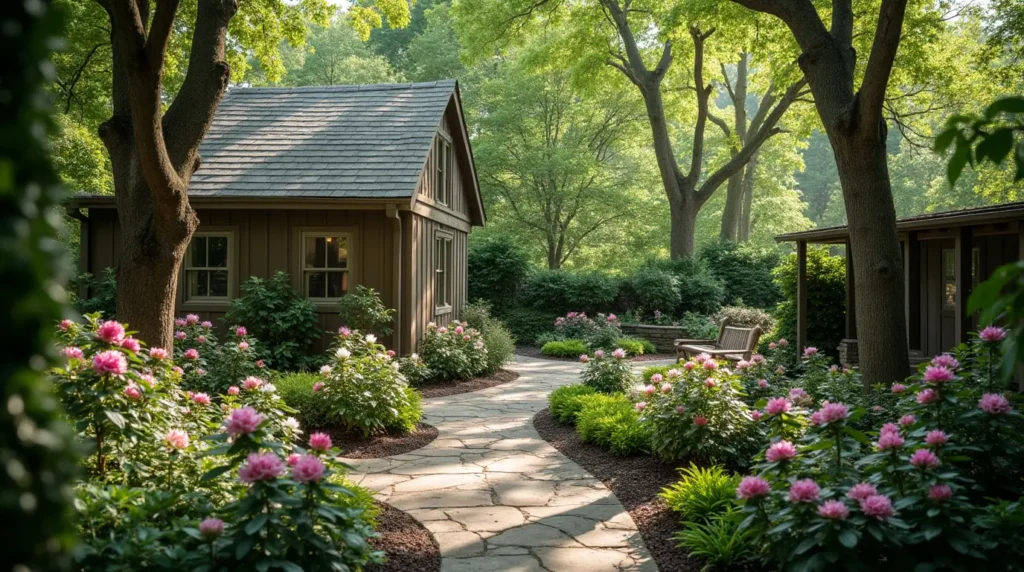
Watering and Mulching Tips for Rhododendrons
Proper watering and mulching are essential for maintaining the health and beauty of your rhododendrons, ensuring they thrive in your Rhododendron Landscaping Uses. Here’s how to get it right:
- Watering Needs: Rhododendrons prefer consistently moist soil but are highly sensitive to waterlogging. Water thoroughly once or twice weekly, adjusting based on rainfall and soil moisture. In periods of drought, water more frequently to avoid plant stress.
- Mulching Benefits: Apply a 2-3 inch layer of organic mulch (such as pine bark, pine needles, or compost) around the base of the plant. Mulch is beneficial for maintaining soil moisture, regulating temperature, and controlling weed growth. However, it’s important to keep the mulch a few inches away from the plant stem to avoid the risk of rot.
- Avoid Overwatering: Ensure your soil has good drainage to prevent root rot. If you notice yellowing leaves or wilting despite adequate watering, check for drainage issues.
By mastering these watering and mulching techniques, you can create an environment where rhododendrons flourish, enhancing the success of your Rhododendron Landscaping Uses.
Pruning Rhododendrons for Shape and Health
Pruning is a key aspect of caring for rhododendrons and ensuring they remain a stunning feature in your shade garden. Here’s how to prune effectively:
- When to Prune: The best time to prune rhododendrons is immediately after they finish blooming, typically in late spring or early summer. This allows the plant to set buds for the next season without disrupting its growth cycle.
- How to Prune: Use clean, sharp pruning shears to remove dead, diseased, or damaged branches. For shaping, trim back overgrown branches to maintain a balanced appearance. Avoid cutting into old wood, as rhododendrons may not regrow from these areas.
- Deadheading Spent Blooms: Remove faded flowers by gently snapping them off at the base. This encourages the plant to focus its energy on new growth rather than seed production.
Regular pruning not only keeps your rhododendrons looking their best but also promotes air circulation and reduces the risk of disease, making it a vital part of Rhododendron Landscaping Uses.
Seasonal Care and Maintenance
To keep your rhododendrons healthy and vibrant year-round, it’s important to provide seasonal care tailored to their needs. Here’s a breakdown of what to do throughout the year:
- Spring:
- Fertilize with a slow-release, acid-forming fertilizer designed for rhododendrons and azaleas.
- Check for pests like aphids or lace bugs and treat them promptly with insecticidal soap or neem oil.
- Water regularly as new growth emerges.
- Summer:
- Keep an eye on soil moisture levels and ensure thorough watering during dry spells.
- Apply a fresh layer of mulch to conserve moisture and protect roots from heat stress.
- Deadhead spent blooms to encourage new growth.
- Fall:
- reduce fertilization to encourage the plant to enter its dormant phase naturally.
- Inspect for signs of disease or pest damage and address any issues before winter.
- Water thoroughly before the first frost to ensure the plant is well-hydrated.
- Winter:
- Protect rhododendrons from harsh winds and heavy snow by wrapping them in burlap or using windbreaks.
- Refrain from heavy pruning during this period, as it may cause stress to the plant.
By following these seasonal care tips, you can ensure your rhododendrons remain healthy and vibrant, maximizing the impact of your Rhododendron Landscaping Uses.
Key Takeaways for This Section:
- Proper watering and mulching are essential for maintaining healthy rhododendrons in your shade garden.
- Pruning after blooming helps maintain shape, promote growth, and prevent disease.
- Seasonal care, including fertilization, pest control, and winter protection, ensures year-round success for your Rhododendron Landscaping Uses.
Conclusion:
Rhododendrons are a game-changer for any shade garden, offering year-round beauty, vibrant blooms, and low-maintenance elegance that make them a standout choice for Rhododendron Landscaping Uses. By selecting the right varieties, preparing the soil, and providing proper care, you can create a stunning outdoor space that thrives even in shaded areas. Whether you’re designing a lush woodland retreat or adding pops of color to a dim corner, rhododendrons bring versatility and charm to your landscape. Embrace the potential of Rhododendron Landscaping Uses and transform your shade garden into a breathtaking sanctuary that delights the senses and enhances your home’s curb appeal. Start your journey today and watch your garden flourish with the timeless beauty of rhododendrons!

